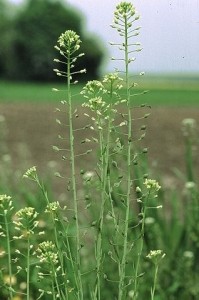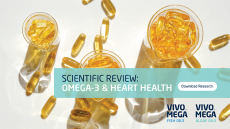Omega-3s from plants: ‘This technology is going to have a massive impact on the industry’

The main omega-3 fatty acids present on the market consist of the marine-sourced eicosapentaenoic acid (EPA, C20:5 n-3) and docosahexaenoic acid (DHA, C22:6 n-3), and alpha-linolenic acid (ALA, C18:3 n-3) from plants like flax and chia.
Omega-3s are not created equal, however, and different fatty acids have been associated with different benefits.
Much attention has been paid to the conversion of ALA to the longer chain EPA, with many experts pegging this conversion at as low as 3% to as much as 20% for vegetarians. The proportion of ALA converted to DHA is very small. In addition, gender plays an important role with women of reproductive age reportedly converting ALA to EPA at a 2.5-fold greater rate than healthy men.
Cardiovascular health
The strongest and most established body of science for the marine omega-3 fatty acids is in relation to cardiovascular health, reported in the early 1970s by Dr Jorn Dyerberg and his co-workers in The Lancet and The American Journal of Clinical Nutrition.
To date, the polyunsaturated fatty acids (PUFAs) have been linked to improvements in blood lipid levels, a reduced tendency of thrombosis, blood pressure and heart rate improvements, and improved vascular function. Beyond heart health, numerous compelling studies support the fatty acids for cognitive function, mood and behavior, eye health, joint health, maternal and infant development, and sports nutrition.
The combination of rapidly expanding market need and “unexpandable” market of fish oil has led to a great opportunity for other sources. Alternatives already in the market place include krill, algae, and even copepods. But it’s the potential to source omega-3 oils from plants that is exciting some very big players.
Down Under
“The production platform for a transgenic plant, whether it’s Camelina or canola, is agnostic to what its end use is, so you could put the oil into aquaculture, and that’s an obvious route to go because that’s where the big demand is,” explained Prof Johnathan Napier, omega-3 Camelina programme leader at Rothamsted Research in the UK, during a panel discussion at the GOED Exchange earlier this year, moderated by your correspondent. The majority of the omega-3 produced is from fish oil, and most of that goes into aquaculture.
“But you could also use the same oil – once you’ve got the appropriate regulatory approval – for human nutrition or terrestrial animal feed or as a feed stock for the people who make super concentrates,” added Prof Napier.
“This technology is going to have a massive impact on the industry and it’s coming for sure.”
Leading the pack from a regulatory perspective is Nufarm and its subsidiary Nuseed, which achieved regulatory approval in Australia in February of this year for the production and use in feed and human consumption of canola that is a source of long-chain omega-3 fatty acids.
In the US, the company has received approval for a significant scale-up of pre-commercial production under the USDA notification scheme, with planting scheduled to take place in April/May in Montana.
Nuseed estimates that one hectare of its omega-3 canola has the potential to provide the omega-3 yield from 10,000 kgs of wild caught fish.
“We remain on track with our plan to commence commercialization in 2019, with production programs planned in the US (pending US approval),” said Andy Thomas, Nuseed Global general manager innovation and strategy, at the time of the approval.
Cargill, working with BASF, is also on track to bring canola engineered to contain higher levels of EPA and DHA to market sometime after 2020. The ag giant recently announced publication of a patent covering the use and sale of plant-based oils to feed fish.
The company stresses that its canola-derived omega-3 product will support additional sector growth and is not to replace fish oil, and provides a more sustainable alternative as it eases pressure on finite marine resources.
Camelina
Related to canola, camelina is the plant of choice for the UK’s Rothamsted Research. Camelina is one of Europe’s oldest oil seed crops.
“We think it has some advantages but it’s not a commodity crop,” said Prof Napier. “Normal Camelina is already approved as an aqua feed ingredient because it has high alpha-linolenic acid levels in the seed oil. We’re trying to enhance that and make an oil that contains EPA and DHA.
“We publish our results so people have a pretty clear understanding of what our camelina oil profile looks like. It’s a mixture of EPA and DHA to about 20% of the total fatty acids.
“We’re not as far advanced as Cargill and Nuseed, but we’ve done small-scale field trials in the UK and in Nebraska and Canada,” he added.
The team published results of field trials in Nature’s Scientific Reports last year, which confirmed the promise of its approach.
So how much of an impact could this have? Writing in the European Journal of Lipid Science and Technology in 2015, Prof Napier stated: “Since Camelina as an oilseed crop can easily yield 0.75 ton of oil/ha, then a GM oil containing similar levels of EPA and DHA to that found in fish oils could make a significant contribution to off‐setting oceanic sources. For example, 200,000 ha of GM Camelina could produce 150,000 metric tons of oil, which could serve as a direct replacement for fish oils in aquafeed, representing 15% of the global oceanic harvest of these oils.
“And although 200,000 ha might seem like a large area, in agricultural terms, it is a quite modest scale—for comparison, the current annual Canadian sowing of related oilseeds such as canola is in excess of 7 million ha. Thus, the proposed 200,000 ha of Camelina represents only a small (<3%) area of land currently given over to vegetable oil production in one country, yet could significantly increase the de novo synthesis of omega‐3 LC‐PUFAs.”
A big challenge will be in how such oil sources are communicated with consumers, and Prof Napier has already had multiple conversations with stakeholders and the general public in the UK and elsewhere about the technology.
“You have to be completely upfront and transparent about what you’re doing, particularly in Europe,” he said. “We’ve always been very open about our efforts to use GM to enable crops to make omega-3 fish oils”
A recent non-GM market entrant is Ahiflower oil from Buglossoides arvensis, which reportedly offers the highest levels of non-GM omega-3 essential fatty acids among commercially available dietary plant oils. Ahiflower oil combines ALA and high levels of stearidonic acid (SDA, 18:4 n-3). SDA converts to EPA at ratio of 30% to 35%, and direct consumption of SDA is far more efficient than consuming large amounts of ALA.
Natures Crops International, the company behind the ahiflower oil product, received a letter of no objection from the FDA for the GRAS status of the ingredient in 2014, and will demo a variety of food and beverage applications at IFT18 in Chicago in July, Greg Cumberford, VP-Strategic Initiatives, Ahiflower, told us.


















